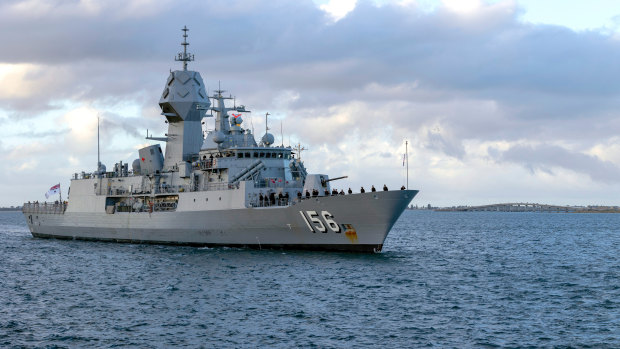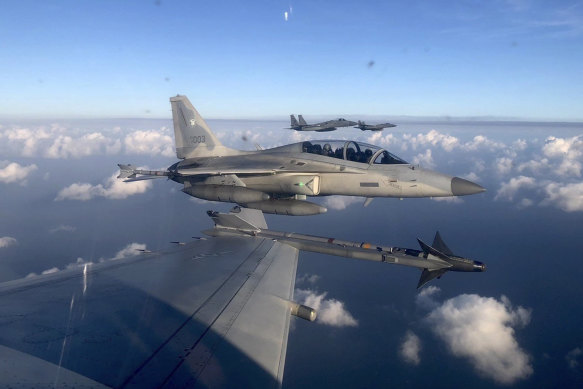
Save articles for later
Add articles to your saved list and come back to them any time.
Singapore: Australia and the Philippines have begun long-awaited joint naval patrols in the South China Sea after months of intensifying friction in the contested waterway.
Defence Minister and Deputy Prime Minister Richard Marles and his Philippine counterpart, Gilberto Teodoro jnr, announced the combined operations in what Manila calls the West Philippine Sea in a statement on Saturday.
HMAS Toowoomba is featuring in the operation with the Philippine armed forces.
They said the first joint patrol in the Philippines exclusive economic zone involves the Royal Australian Navy frigate HMAS Toowoomba, an Australian Air Force P-8A maritime surveillance aircraft, two Philippine Navy vessels and five Philippine Air Force surveillance planes. The patrols are taking place from Saturday until Monday.
“Australia and the Philippines are firmly committed to a peaceful, secure and prosperous region, where sovereignty and agreed rules and norms are respected,” Marles said.
“The first joint patrol between the Australian Defence Force and Armed Forces of the Philippines demonstrates this important commitment.”
The HMAS Toowoomba transited through the sensitive Taiwan Strait this week, less than a fortnight after an incident in which Australian divers sustained minor ear damage from a Chinese destroyer’s sonar pulses.
Also this week the United States and the Philippines resumed joint patrols in the South China Sea and in the waters around the South-East Asian archipelago’s northernmost islands near Taiwan.
The United States and Philippines conducted joint maritime and air patrols in the South China Sea this week.Credit: Philippine Air Force
That development drew a stern response from Beijing, which claimed that, by mustering foreign forces, the Philippines had “stirred up trouble and engaged in hype, undermining regional peace and stability”.
The Australian patrols, first signalled by Marles on a visit to Manila in February, are the latest Western effort to support the Philippines, which has become more vocal in protesting against encroachments and increasing harassment by China’s fleet of Coast Guard and maritime militia vessels.
They fall under the umbrella of a strategic partnership signed in September by Prime Minister Anthony Albanese and Philippine President Ferdinand Marcos jnr, who has vowed to stand up to China and not cede an inch of Philippine waters.
“The fact that it follows on from the US shows that the Philippines is really trying to demonstrate international support for it. That it is not an isolated country,” said Jay Batongbacal, an associate professor at the University of the Philippines College of Law and director of its Institute for Maritime Affairs and Law of the Sea.
“Even though it might have a military that is a little bit short on capabilities compared to other countries, it can leverage alliances and friendships to shore up its defensive capabilities.”
The South China Sea’s status as a potential flashpoint for conflict has been rammed home by a series of altercations in which Chinese ships have sought to block the Philippines’ resupply of a dilapidated World War II-era ship intentionally grounded by Manila to lay claim to a disputed shoal.
Last month, the two countries blamed each other for a collision between a Philippine resupply boat and a Chinese maritime militia vessel that was captured on camera by journalists on board, while Manila has repeatedly complained of Chinese ships firing water cannons.
Marcos met Chinese President Xi Jinping on the sidelines of the APEC summit in San Francisco earlier this month, telling him: “I do not think anybody wants to go to war”. But in a speech in Hawaii later, he admitted the state of play at sea with China “has become more dire”.
Batongbacal said he expected a reaction from Beijing to the Australian-Philippines patrols even if they were nowhere near Chinese territory.
“For me, it shows their insecurity,” he said. “Also for me, it really demonstrates how excessive their [territorial] claims really are. For them to feel threatened by these patrols so close to the Philippines shore, it’s really outrageous, I think.”
Beijing asserts ownership of nearly all the resource-rich, strategically key South China Sea through its updated 10-dash line, ignoring the decision of an international tribunal in The Hague in 2016 that determined its sweeping, historic claims were invalid.
China has fortified its presence by militarising artificial islands and, in 2012, seizing Scarborough Shoal, the largest atoll in the waterway, following a stand-off with the Philippines.
Get a note directly from our foreign correspondents on what’s making headlines around the world. Sign up for our weekly What in the World newsletter.
Most Viewed in World
From our partners
Source: Read Full Article

